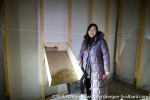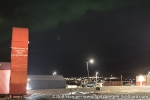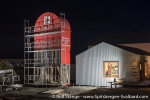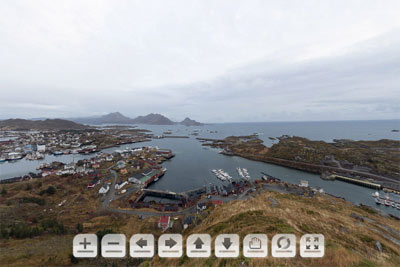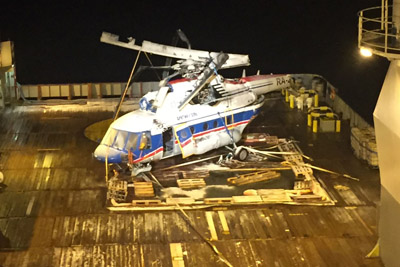-
current
recommendations- Liefdefjord
New page dedicated to one of Spitsbergen's most beautiful fjords. Background information and many photos.
- New Spitsbergen guidebook
The new edition of my Spitsbergen guidebook is out and available now!
- Liefdefjord
New page dedicated to one of Spitsbergen's most beautiful fjords. Background information and many photos.
Seitenstruktur
-
Spitsbergen-News
- Select Month
- April 2024
- March 2024
- February 2024
- January 2024
- December 2023
- November 2023
- October 2023
- September 2023
- August 2023
- July 2023
- June 2023
- May 2023
- April 2023
- March 2023
- February 2023
- January 2023
- December 2022
- November 2022
- October 2022
- September 2022
- August 2022
- July 2022
- June 2022
- May 2022
- April 2022
- March 2022
- February 2022
- January 2022
- December 2021
- November 2021
- October 2021
- September 2021
- August 2021
- July 2021
- June 2021
- May 2021
- April 2021
- March 2021
- February 2021
- January 2021
- December 2020
- November 2020
- October 2020
- September 2020
- August 2020
- July 2020
- June 2020
- May 2020
- April 2020
- March 2020
- February 2020
- January 2020
- December 2019
- November 2019
- October 2019
- September 2019
- August 2019
- July 2019
- June 2019
- May 2019
- April 2019
- March 2019
- February 2019
- January 2019
- December 2018
- November 2018
- October 2018
- September 2018
- August 2018
- July 2018
- June 2018
- May 2018
- April 2018
- March 2018
- February 2018
- January 2018
- December 2017
- November 2017
- October 2017
- September 2017
- August 2017
- July 2017
- June 2017
- May 2017
- April 2017
- March 2017
- February 2017
- January 2017
- December 2016
- November 2016
- October 2016
- September 2016
- August 2016
- July 2016
- June 2016
- May 2016
- April 2016
- March 2016
- February 2016
- January 2016
- December 2015
- November 2015
- October 2015
- September 2015
- August 2015
- July 2015
- June 2015
- May 2015
- April 2015
- March 2015
- February 2015
- January 2015
- December 2014
- November 2014
- October 2014
- September 2014
- August 2014
- July 2014
- June 2014
- May 2014
- April 2014
- March 2014
- February 2014
- January 2014
- December 2013
- November 2013
- October 2013
- September 2013
- August 2013
- July 2013
- June 2013
- May 2013
- April 2013
- March 2013
- February 2013
- January 2013
- December 2012
- November 2012
- October 2012
- September 2012
- August 2012
- July 2012
- June 2012
- May 2012
- April 2012
- March 2012
- February 2012
- January 2012
- December 2011
- November 2011
- October 2011
- September 2011
- August 2011
- May 2011
- April 2011
- March 2011
- February 2011
- January 2011
- December 2010
- November 2010
- September 2010
- August 2010
- July 2010
- June 2010
- May 2010
- April 2010
- March 2010
- February 2010
- November 2009
- October 2009
- August 2009
- July 2009
- June 2009
- May 2009
- April 2009
- March 2009
- February 2009
- January 2009
- December 2008
- November 2008
- October 2008
- August 2008
- July 2008
- June 2008
- May 2008
- April 2008
- March 2008
- February 2008
- April 2000
- Select Month
-
weather information

| THE Spitsbergen guidebook |
Home → November, 2017
Monthly Archives: November 2017 − News
Santa Claus’ Letterbox – 20th November 2017
If you have been to Longyearbyen since December 2013, then you have seen the huge, red letterbox just upon entering town, as you came from the airport. This was the Santa Claus Mailbox, and here you could post your letters to Santa Claus.
The letterbox was an idea from Po Lin Lee from Honkong, but she did not just send an idea and money from far away. She was and is in Longyearbyen and puts a lot of effort into hear postal project. But – the permission to have it standing there was only temporary. It ran out on December 2015, and then, the letterbox was to be removed again, or a new permission had to be obtained.
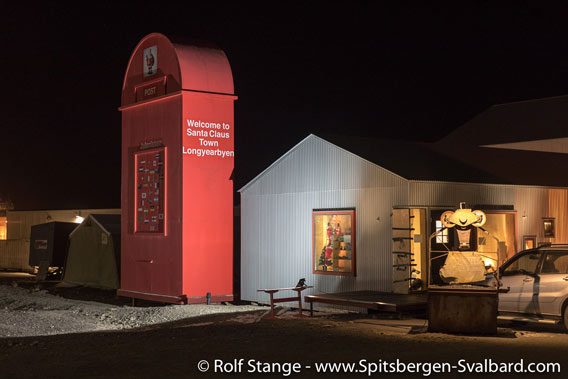
Neither of this happened, until Monday. What happened, was a fight that took a lot of time and energy. Letters, admonitions and warnings were written, bureaucrats and lawyers did what bureaucrats and lawyers do. Neighbours would have to be contacted to give their consent to a renewed permission for the letterbox to remain in place, but is is said that this never happened. Language difficulties seem to have played a role.
Then, the local administration (Longyearbyen Lokalstyre, LL) set a deadline: the letterbox was to disappear on Monday, November 20, 2017. The order to remove it had already been given by LL to a local construction firm. The invoice about the substantial amount of 129,000 NOK (about 13,300 Euro) was in the end to be paid by Po Lin Lee.
Who reacted by ordering a company from the mainland to take the letterbox down in a more carefuly way, so it could be re-built again later somewhere else. Before that happened, Po Lin Lee gave visitors a last chance to visit the letterbox, only to find out that the door had been firmly locked with big screws – without her, the owner, knowing about it. Also, there were traces of forecul break-in on the door, possibly from a local company who had already removed the electrical system on behalf of the local administration.
Gallery – Santa Claus’ Letterbox – 20th November 2017
- gallery anchor link: #gallery_1363
Click on thumbnail to open an enlarged version of the specific photo.
Meanwhile, the discussion in local social media group had gained some momentum. Some were happy that local democracy had won a victory and the letterbox was now about to disappear, while others expressed sadness. There are different opinions regarding the question if Longyearbyen should be presented to the global public as a Santa Claus Town. The local legend actually says that Santa Claus lives in Mine 7b, above Nybyen. During the Christmas period, there is light up there, and there is a letterbox (of more conventional dimensions) next to the road below it, where children can send their letters to Santa Claus as part of the local christmas happenings.
The big Santa Claus letterbox was now removed by a company on behalf of Po Lin Lee. According to her, there are several interested parties that might step in and take over the letterbox to put it up again elsewhere in Scandinavia. And Po Lin Lee has not given up hopes that she might actually be able again to put it up somewhere else in Longyearbyen.
Happy Christmas time to everybody!
More arctic Christmas stories? – Click here to check out my (German) book with historical Christmas stories from high latitudes.
Picture frames made of Spitsbergen-driftwood available for the first time in limited edition
During a walk on any of Spitsbergen’s beautiful beaches, you can’t help it but be amazed about the impressive amounts of driftwood. Not only does it add a aesthetical aspect to the otherwise rather sterile shoreline, but it does also have a fascinating history: Just as Fridtjof Nansen did with his famous ship the Fram, did the wood drift all the way from Siberia with the pack ice across the Arctic Ocean and all the way to the north Atlantic, where it was thrown onto an arctic beach in Svalbard, Greenland, Iceland, Jan Mayen or Frans Josef Land.
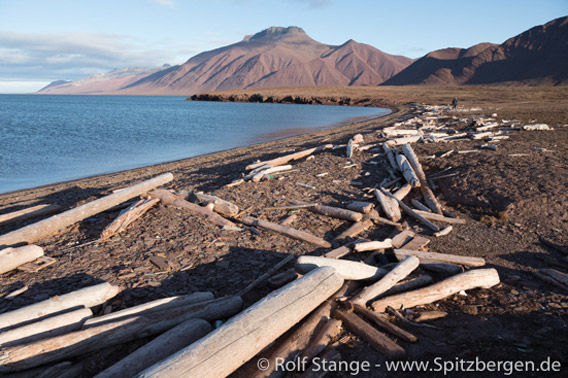
Driftwood at Wigdehlpynten – Woodfjord, Spitsbergen
And there we have it. If you are a trapper, you can use it to build a hut (that was rarely done, too much effort) or as firewood (that was very common). I am not a trapper, but a photographer, so it was an obvious idea to use the driftwood to make picture frames. Can you imagine a more appropriate picture frame for arctic pictures than one made of driftwood from Spitsbergen?
Turning driftood into picture frames required more effort than we expected to begin with. We made the first serious attempts several years ago, when master carpenter Wolfgang Zach opened his carpenter’s workshop in Longyearbyen. He called his little company “Alt i 3”, which is a play of words: “3” is “tre” in Norwegian, which also means “tree” or “wood” at the same time. So it translates to “Everything out of wood”. We found also out that you do actually need a license to export driftwood from Spitsbergen, so that was another thing we had to take care of.
So I started collecting driftwood in small amounts. The first project was a bookshelf for our flat in Longyearbyen, and at the same time we started making the first prototypes of picture frames. We just had to find out what works well with this very special material. One of the discoveries that we made was that if you cut and sand it, it looks as fresh and new as a wooden board that you just bought in the building supply store. Which is of course not the idea with picture frames made from arctic driftwood. So I started looking for pieces of wood that had a good shape to start with. Most pieces of driftwood are not natural, but rather trees cut in forestry in Siberia or even ready-made boards. Completely natural driftwood – trees with roots – are actually quite rare.
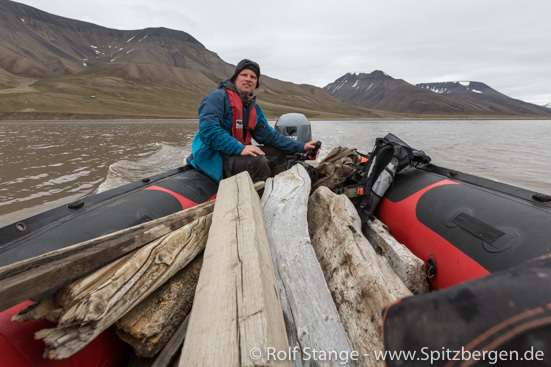
Rolf Stange transporting driftwood to Longyearbyen.
I took this driftwood in small amounts to Longyearbyen, were it had to be stored and slowly dried over longer periods of time. Then, Wolfgang and I could start making the first picture frames in his carpenter’s workshop. After some experimenting, we had a prototype that we both liked, so the master carpenter could start to produce the first set of 16 picture frames – all of them were made by Wolfgang Zach in Longyearbyen.
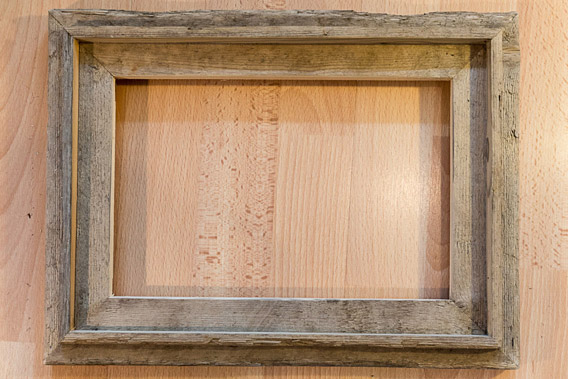
Now, these had to get to Germany. If you know me, then it won’t surprise you to read that they travelled from Spitsbergen to Franeker in the Netherlands on the good sailing ship Antigua and from there via Münster and Dresden to my shipping department in northeastern Germany.
After this long journey from Siberia, down a river, with the ice across the Arctic Ocean to a beach in Spitsbergen, from there to Longyearbyen to Wolfang’s carpenter’s workshop, from there on a sailing ship to Europe. And there they are now, the very first series of 16 picture frames from Spitsbergen driftwood, available for the first time since November 2017.
Every single picture frame is a unique specimen. This has to do with the history of the wood, the natural character of the material, the manual production. So I took photographs of all frames, which you can see on this page (click here), which also has all the technical information (dimensions, price etc.)
New 360° panorama: Ballstad, Lofoten
A new panorama on this site gives a 360 degree view of Ballstad on Vestvågøy, one of the Lofoten islands in north Norway. I shot it freehand and the weather was quite typical November.
Part of the new panorama of Ballstad (Lofoten).
Spitsbergen-calender 2018: the east coast
In February, the Spitsbergen-calendar 2018 takes us to the east coast. In the winter season, this is a popular destination for snowmobile day-trips, enabling relatively many people to see this grand winter scenery. Storfjorden is frozen to fast ice here in Mohnbukta, and some smaller bits and pieces of glacier ice are stuck in the ice. They broke off last summer from the combined glacier fronts of Königsbergbreen/Hayesbreen/Heuglinbreen, of which we can see a small part in the background.
It is quite common that polar bears are roaming through this icy landscape. We will see if we are lucky enough to spot them somewhere later …
The sun is just starting to rise above the horizon in Spitsbergen in mid-February, and the days are still short. It is still too early for longer trips. But the light can be breathtakingly beautiful!
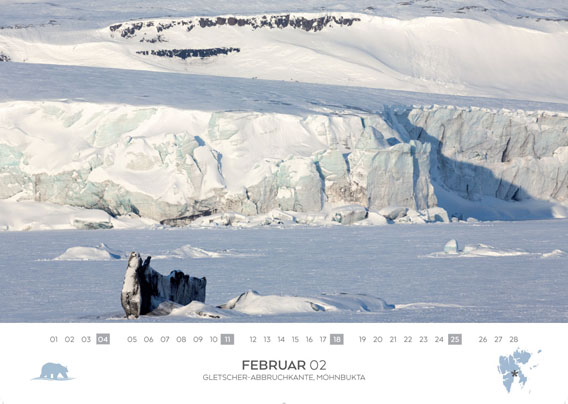
Spitsbergen-Calendar 2018: February. Ice-landscape on the east coast.
Russian helicopter wreck lifted
The wreck of the Russian helicopter that crashed into Isfjord close to Barentsburg previous Thursday was lifted last night. The special ship Maersk Forza was brought to Spitsbergen for this task and completed the work successfully on the night from Friday to Saturday. There were 8 persons on board the MI-8-helicopter when it crashed, including 5 crew members and 3 scientists. One body had already been found some days ago about 130 m away from the wreck. There is no trace so far from the other crew members, and the search for them will be continued.
The cockpit voice recorder could secured together with GPS units which are expected to have the actual flight track saved. They will be brought to Moskva for further investigations.
Meanwhile, questions are raised regarding the cause of the crash and the circumstances of the flight. The data recorders that were secured are likely to shed light on the actual crash. It seems that the flight was not legal according to applicable Norwegian legislation. The Norwegian flight permit issued to the operator covers only flights in direct combination to the operations of the mining company Trust Arktikugol, for example transport of company employees between Longyearbyen and Barentsburg. Commercial flights and transportation of tourists and scientists are explicitely excluded.
There were 3 scientists on board the helicopter when it crashed.
The wreck of the Russian helicopter, which crashed on October 26 close to Barentsburg into Isfjord, on board the ship Maersk Forza (photo © SHT).
Source: Svalbardposten
News-Listing live generated at 2024/April/25 at 07:13:16 Uhr (GMT+1)
